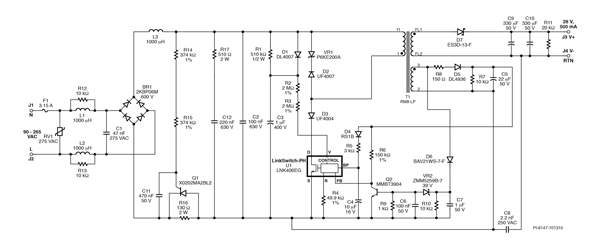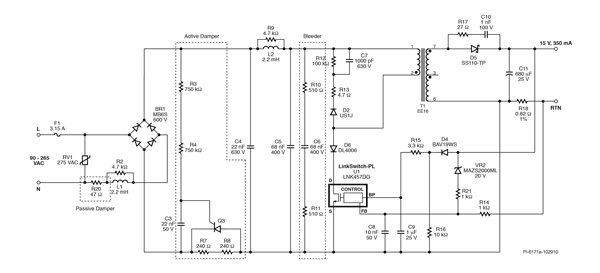Lighting designs with flicker-free LED dimming
Using existing triac controllers and wiring offers a number of challenges for LED lighting
BY DAVID NEW
Power Integrations
www.powerint.com
LED lighting, and the potential that it brings, is moving to the forefront of residential and commercial lighting markets. However, to maximize the success and adoption of solid-state lighting for retrofit lamps, the LED lamps should be capable of dimming when used with existing controllers and wiring.
Attempts to dim LED lamps have encountered a number of problems resulting in flickering and other undesirable behavior. This article explores the typical TRIAC dimmer, some of the challenges of using it with LED lighting, and two interesting new power management solutions that solve these issues while meeting new and emerging energy, power factor, THD, and EMI specifications.
Incandescent-bulb-replacement LEDs contain an LED array connected in a series string and arranged to provide an even spread of light. The LED string must be driven by a constant current supply, which must be tightly controlled to ensure the level of luminous flux.
The TRIAC dimmer
A common lighting dimmer available today is the leading-edge TRIAC dimmer. For an LED lamp to be dimmable, the lamp’s power supply must interpret the variable phase angle output from the TRIAC controller to monotonically adjust the constant current drive.
The difficulty of achieving this while keeping the dimmer working correctly may result in flickering, audible noise, and blinking as the light level is adjusted. These are generally caused by a combination of false triggering or premature shutdown of the TRIAC and inadequate control of the LED current.
For reliable dimming down to low levels, the TRIAC must remain conducting almost to the point where the AC voltage falls to zero; the required holding current is typically in the range of 8 to 40 mA. With LED lamps consuming less than 10% of the power of an equivalent incandescent lamp, the current can easily fall below the TRIAC’s holding current with resulting inconsistent behavior.
There are other issues too. Energy Star specifications require a minimum power factor of 0.7 for residential and 0.9 for commercial/industrial applications. Tight requirements for efficiency, output current tolerance and EMI must also be met, and the power supply must respond safely in the event of a short or open circuit of the LED load.
LED driver ICs
Recent developments by semiconductor firms have shown how the challenges of driving LEDs can be addressed. As an example, let’s look at Fig. 1 , which shows a 14-W LED driver built around the LNK406EG IC.
The LinkSwitch-PH and LinkSwitch-PL families of ICs from Power Integrations incorporate a 725-V power MOSFET and a continuous-conduction-mode primary-side PWM controller in a single device. The controller provides both power factor correction and a constant current output up to 50 W. The IC’s primary-side-control technique provides highly accurate constant-current control, eliminating the need for an optocoupler and the supporting circuitry commonly used in isolated flyback power supplies, and the IC’s control technique provides the power factor correction while eliminating the need for a high-voltage aluminum electrolytic bulk capacitor.

Fig. 1: Schematic of an isolated, triac-dimmable, high-power-factor, universal-input, 14-W LED driver.
LinkSwitch-PH ICs can be used in both isolated and nonisolated supplies, and for either nondimming or dimming (TRIAC or PWM) designs. For TRIAC dimming designs, the devices provide flicker-free operation over an exceptionally wide dimming range. Constant-current control allows for ±25% voltage swing, eliminating the need to bin LEDs for forward voltage drop, and a current accuracy of ±2.5% ensures consistent luminous flux.
The 14-W LED design achieves compatibility with standard leading-edge TRIAC ac dimmers, a dimming range of 1,000:1 (500 mA:0.5 mA), high efficiency (>85%), and high power factor (>0.9).
For low-power nonisolated designs that require power factor correction, the LinkSwitch-PL family can provide up to 16 W in nondimming or dimming designs. The very low parts count of this single-stage solution allows its use in space-constrained enclosures. Figure 2 is the schematic for a 5-W dimmable power-factor-corrected LED driver using a LNK457DG.

Fig. 2: Schematic of a 5-W dimmable LED power supply using LNK457D.
In this design, no bias winding is required on the transformer and the constant-current-mode setpoint is determined by the voltage drop that appears across R18, which is fed to the feedback pin of U1. A dimming range of 100:1 is achieved without flickering or blinking with all dimmer types, including leading-edge TRIAC dimmers. ■
Advertisement
Learn more about Power Integrations





